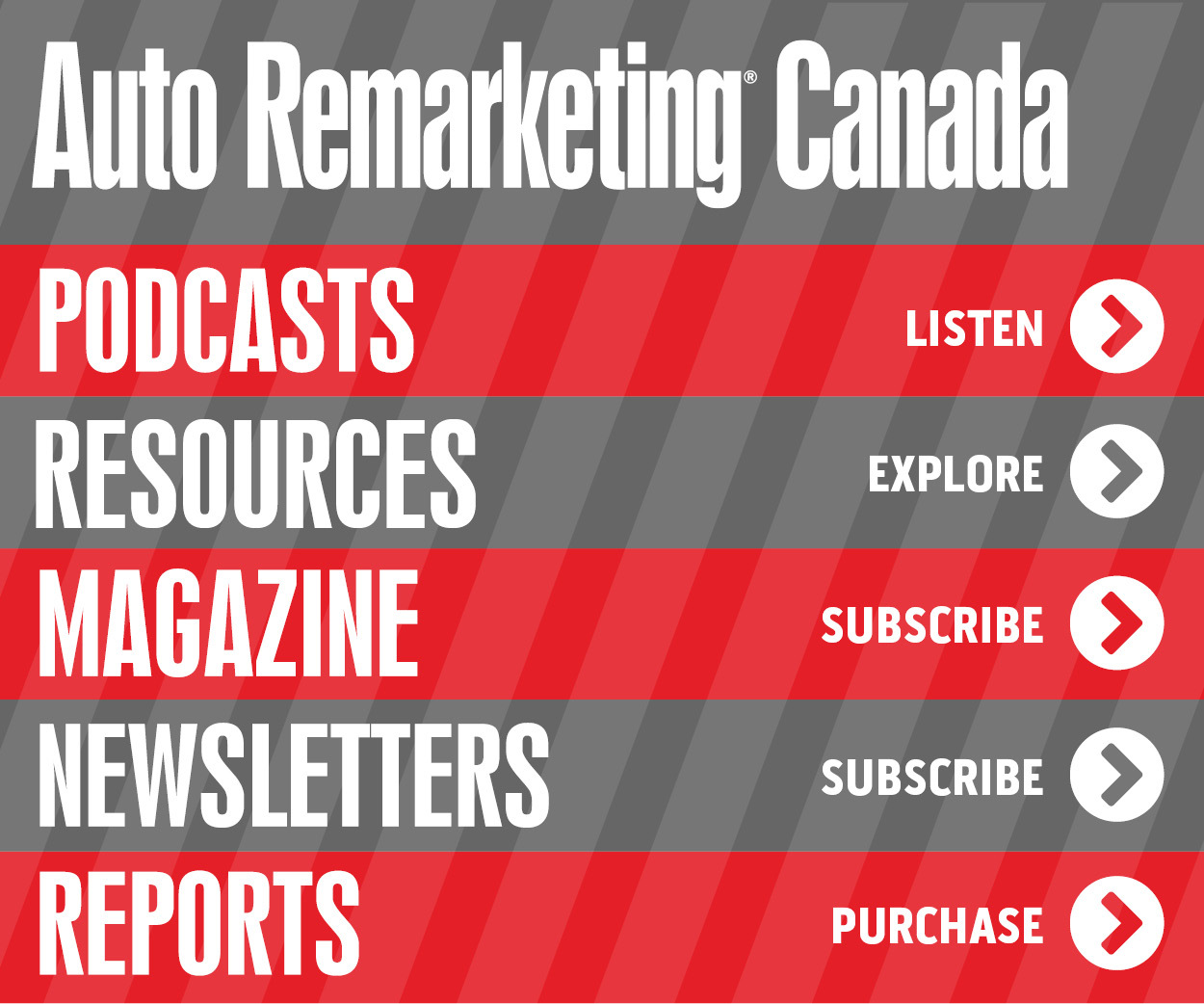Subscribe today to get the latest news and trends shaping the pre-owned market.
By subscribing, you agree to receive communications from Auto Remarketing and our partners in accordance with our Privacy Policy. We may share your information with select partners and sponsors who may contact you about their products and services. You may unsubscribe at any time.
Note: This and all Women & Automotive Profiles in Leadership feature stories were compiled prior to the COVID-19 pandemic's most severe impacts in North America.
Human resources, strategies for a happier, healthier workplace, the tools managers use to facilitate programs that make the workplace tick, and more. These have all changed drastically in the past 20 to 30 years as digitization took over. And the 9 to 5, one-company-until-retirement lifestyle gave way to the ever-competitive, fast-paced gig economy we know today.
That said, many companies manage to find a balance between the old and new, fostering employee retention by providing flexibility in work hours, pay structure and more, to ensure they not only attract the best talent, but also keep it around. And technology plays a huge role in these companies’ strategies to ensure a positive work environment. Think about the strategies at the Googles, Apples and Facebooks of the world.
But, there’s more to workplace health than just the latest technology.
Debbie Butt, area parts and service manager at Toyota Canada and a 2019 Women & Automotive Profile in Leadership honoree, cited respect, acknowledgement and collaboration as the three biggest factors contributing to a happy and healthy workplace in 2020 — surpassing technology and practices.
That said, although technology certainly can’t solve all of a workplace’s employee challenges, it can certainly help streamline through mobile apps, human resources software and more, which can all work to simplify processes and save your employees’ valuable time.
And the majority of companies may need to consider speeding up their adoption.
That’s according to Denise Broady, chief operating officer of WorkForce Software, a company that looks to solve businesses’ unique time and attendance, scheduling and compliance needs in a single cloud solution.
Broady told Auto Remarketing Canada in an emailed Q&A, “Companies and organizations are slow to adopt user-friendly technology giving their employees the flexibility they need to balance their work and life.”
She offered this example: Universities are often populated with hourly workers that are students or millennials who expect access to a mobile device, especially for work purposes.
“I was surprised to find out that one of the universities we work with did not have the budget to roll out mobile for their student population,” Broady asked. “Imagine if you were sick or wanted to quickly swap shifts with someone. Who wants to go through the hassle of logging onto a laptop? It’s just not the way we work anymore.”
Technology can be useful for improving employee connection and also for shifting tasks and accountability to employees, as well. Google Hangouts, YouTube channels and other social media platforms keep employees connected, even if they are not sharing the same office space.
Lisa Price, the first-ever chief people officer at KAR Global, highlighted a few tools that illustrate tech usage to gauge employee satisfaction when sharing with Auto Remarketing Canada notes on strategies and processes that work to create a happier, healthier workplace in 2020.
In 2018, KAR Global moved from an annual employee survey tactic to quarterly pulse surveys and feedback mechanisms, and the company also has capabilities to ask a single question to employees to gauge opinions on interests or suggestions.
“Our more frequent assessment and responsive action approach has increased our engagement and participation levels,” Price said.
Feedback tools have obviously graduated from paper surveys to big data value-building tools for today’s enterprises.
And companies like Canadian startup Thoughtexchange, led in part by ex-Googler Jessica Nordlander. are coming up with crowdsourcing tech to “engage the silent majority in the workplace.”
The company’s Software as a Service platform lets leaders crowdsource answers — from across their entire organizations — to open-ended questions.
The company said via email, “The disarmingly simple idea helps leaders tap directly into the collective intelligence of their organizations.”
Further exploring software solutions, technology such as HRIS (Human Resources Information Systems) enable employees to book and maintain their vacations, sick days and appointments without having to talk face to face with a manager, and also gives employees the ability to schedule their own calendars, on their own time.
“This technical solution can remove the stress of asking for days off and gives employees the freedom to schedule their calendars on their own time,” Steph Barlow, director of people and culture at Iversoft, a digital consultancy and technology partner for innovative strategies and precision execution, told Auto Remarketing Canada.
HR can also reduce time spent on paperwork by giving employees the ability to enroll themselves in benefits online. And training portals can help with onboarding and allow the individual to go at their own pace.
For larger organizations, the use of enterprise-wide intranets has also become widely used, which is a computer network for sharing information, tools, systems, and more only within that specific organization.
KAR’s enterprise-wide intranet, known as “The Hub”, provides current and consistent messaging to employees, as well as a forum to “showcase company, team and individual successes, view leadership profiles, nominate featured employees and express opinions and suggestions on the chat feed,” Price said.
Vladimir Stepuro, HR director at ScienceSoft, an IT consulting and custom software development company, honed in on one aspect of the intranet as a tool for workplace health and efficiency: gamification, or the application of game-design elements and principles in non-game contexts.
“Happy employees are engaged employees. I think gamification is a strong tool to increase engagement at the workplace and motivate employees. Today, gamification components are obligatory intranet features. For example, an intranet can have employee leaderboards showing points gained for successful completion of job tasks. These leaderboards nurture competitiveness among employees, they work harder to take the first place and get a bonus like an extra day off,” Stepuro said in an emailed Q&A.
Employees can also be encouraged to use dedicated mobile apps.
“Some contain simple exercises that employees can practice during breaks; others just send hourly notifications about having a break from work. These apps serve as an effective preventive measure to health problems and help employees reduce stress,” Stepuro said.
And there is likely not one area more impacted by technology and the rise of mobile than office communication. Team members can always stay connected through chat tools like Slack, and project briefings are common via tools like Trello. Price said KAR also recently implemented an enterprise-wide “recognition platform” that provides employees opportunities to commend and/or celebrate each other and recognize work anniversaries.
“The response to this effort has been incredible,” said Price.
Creating a positive environment
But again, it’s not all about technology. Many enterprises are turning to more simple answers to create a happy, healthy workplace, often involving environmental factors like air quality.
According to Leslie Shull, an assistant professor of business and real estate at Sacramento City College and founder of Let’s All Flourish, a health and wellness company, one of the ways an employer can improve workplace satisfaction and engagement is to discover the strengths of its employees.
“When management and employees focus on each other’s strengths and what is great about each other and how to use each other’s complementary strengths to get tasks done — it creates an amazing collaborative culture,” Shull said.
Subscribe to Auto Remarketing to stay informed and stay ahead.
By subscribing, you agree to receive communications from Auto Remarketing and our partners in accordance with our Privacy Policy. We may share your information with select partners and sponsors who may contact you about their products and services. You may unsubscribe at any time.
And while there are many new and emerging technologies and strategies to improve the culture of your workplace, many times a simple solution is all you need to boost employee morale and productivity, such as air control, or new lighting.
Indoor plants are known to improve air quality, reduce stress and anxiety, and improve mental focus and productivity. And some companies are hiring air control specialists, as well for their spaces.
And investing in wellness programs is on the rise, as well. For example, programs like internal athletics and yoga classes, wellness healthcare budgets and flexible benefits — all tools that keep employees happy and healthy.
Regardless of technology and new strategies for a healthy workplace, for Carrie Oliva, director of product at Strathcom Media and a 2019 Profile in Leadership honoree, it all starts — and ends — with a focus on the well-being of employees.
“Related to that, we have to accept and value each individual for who they are, and the unique abilities, ideas, and skills they bring to our organization. The result of this is two-fold, allowing us to keep boosting that workplace morale while also solving problems we encounter,” said Oliva. “Because who knows what that next problem or roadblock looks like? I just know that someone on our team has the ability to look at it with a fresh set of eyes, and potentially solve it.”
Subscribe to receive our daily e-newsletter and never miss the latest industry news, trends, and insights across the used-car and remarketing space.



